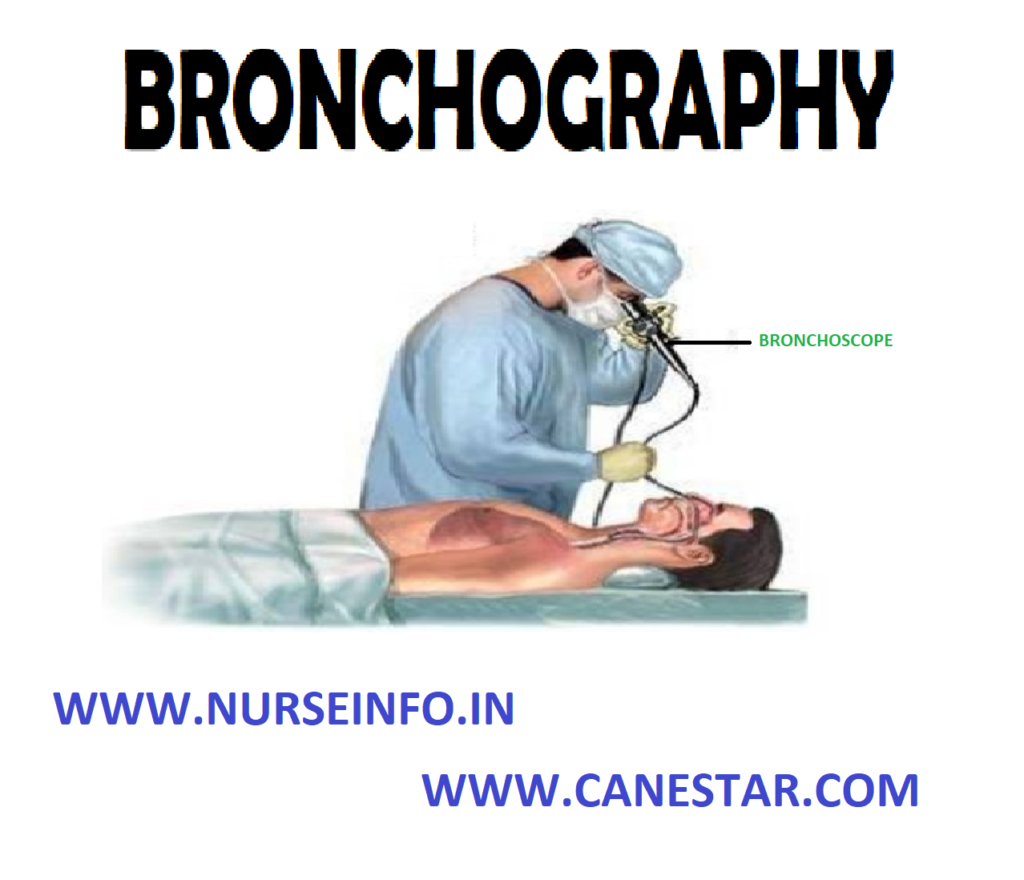BRONCHOGRAPHY – Purpose, Client Preparation, Procedure, Post-Procedural Care, Contraindications and Factors Affecting Diagnostic Results
Bronchography is a X-ray test to visualize the trachea, bronchi and entire bronchial tree after a radiopaque iodine contrast liquid is injected through a catheter into the tracheobronchial space. The bronchi are coated with the contrast dye, and a series of X-ray is then taken
PURPOSE
To detect bronchial obstruction such as foreign bodies and tumors
Indications: bronchial obstructions (e.g. foreign bodies, tumors, cysts or cavities, bronchiectasis)
CLIENT PREPARATION
- Obtain a signed consent form. Check that the consent form is signed premeditation is given
- Explain the procedure of the test. Gradually clients are extremely apprehensive about this test and are fearful that they may be unable to breath
- Reassure the client that airway will not be blocked. Inform the patient that he or she may have a sore throat after the test as the result of catheter irritation
- Obtain history of hypersensitivity to anesthetics, iodine and X-ray dyes. Usually the client will receive an expectorant several days before the test to loose secretions
- Record the vital signs
PROCEDURE
- A consent form should be signed
- The client should be NPO for 6 to 8 hours before the test
- Oral hygiene should be given the night before the test and in the morning. This will decrease the number of bacteria that could be introduced into the lungs
- Postural drainage is performed for 3 days before the test. This procedure aids in the removal of bronchial mucus and secretions
- A sedative and atropine are usually given 1 hour before the tests. The sedative/tranquilizer is to promote relaxation; atropine is to reduce secretions during the test
- A topical anesthetic is sprayed into the pharynx and trachea. A catheter is passed through the nose into the trachea, and a local anesthetic and iodized contrast liquid are injected through the catheter
- The client is usually asked to change body positions so that the contrast dye can reach most areas of the bronchial tree
- Following the bronchography procedure, the client may receive nebulization and should perform postural drainage to remove contrast dye. Food and fluids are restricted until the gag (cough) reflex is present
POST-PROCEDURAL CARE
- Assess for signs and symptoms of laryngeal edema (e.g. dyspnea, hoarseness, apprehension). This could be caused by a traumatic insertion of the catheter
- Assess for allergic reaction to the anesthetic and iodized contrast dye (e.g. apprehension, flushing, rash, urticaria, dyspnea, tachycardia and hypotension)
- Check the gag reflex to see that it has returned before offering food and fluids. Have the client swallow and cough or tickle the posterior pharynx will a cotton swab; if gag reflex is present, offer ice chips or sips of water before food
- Monitor vital signs. The temperature may be slightly elevated for 1 or 2 days after the test
- Checks breathe signs. If bronchi and fever are present, notify the health care providers and record on the client’s chart
- Have the client perform postural drainage post-test? This procedure helps with the removal of the contrast dye. Physiologic damage will not occur if some of the dye remains in the lungs for a period of time
- Offer throat lozenges or an ordered medication for answer their questions
- Be supportive of the client and family. Be available to answer their questions
CONTRAINDICATIONS
- Bronchoscopy is contraindicated during pregnancy
- Client is hypersensitive to anesthetics, iodine or X-ray dyes
FACTORS AFFECTING DIAGNOSTIC RESULTS
- Secretions in the trace bronchial tree can prevent the contrast dye from coating the bronchial walls


